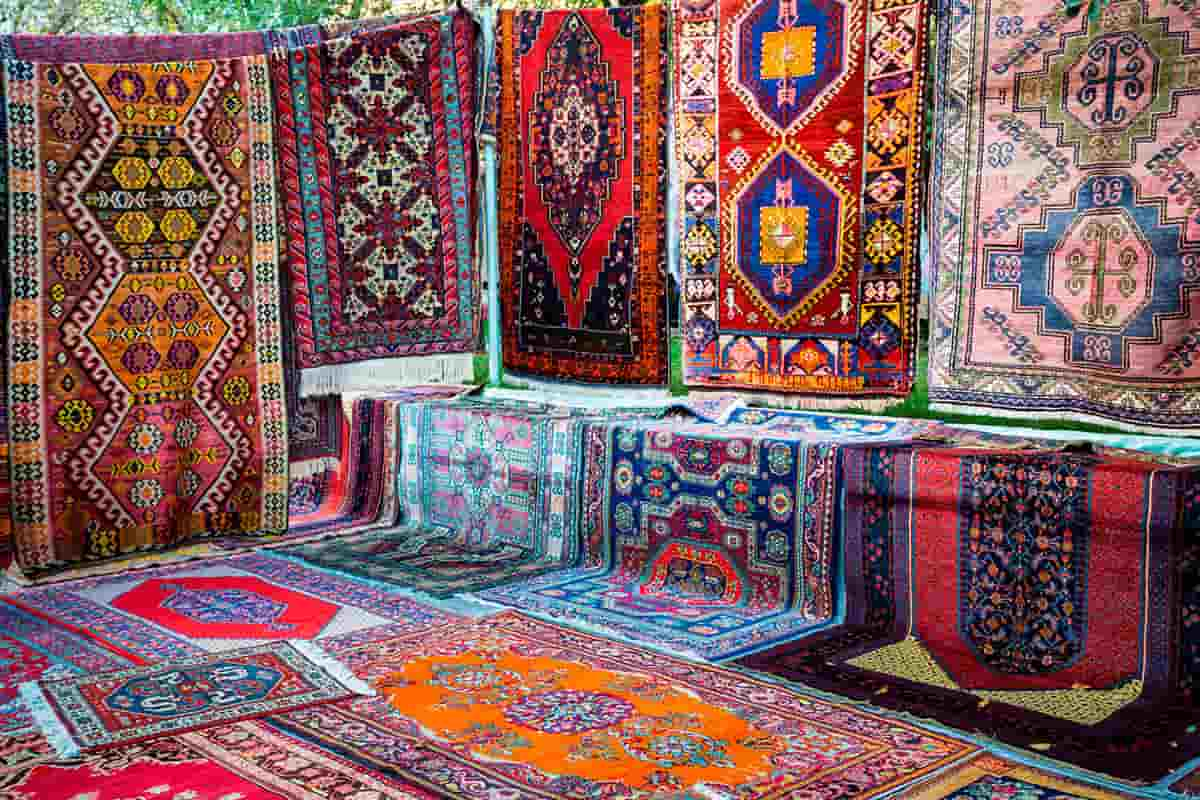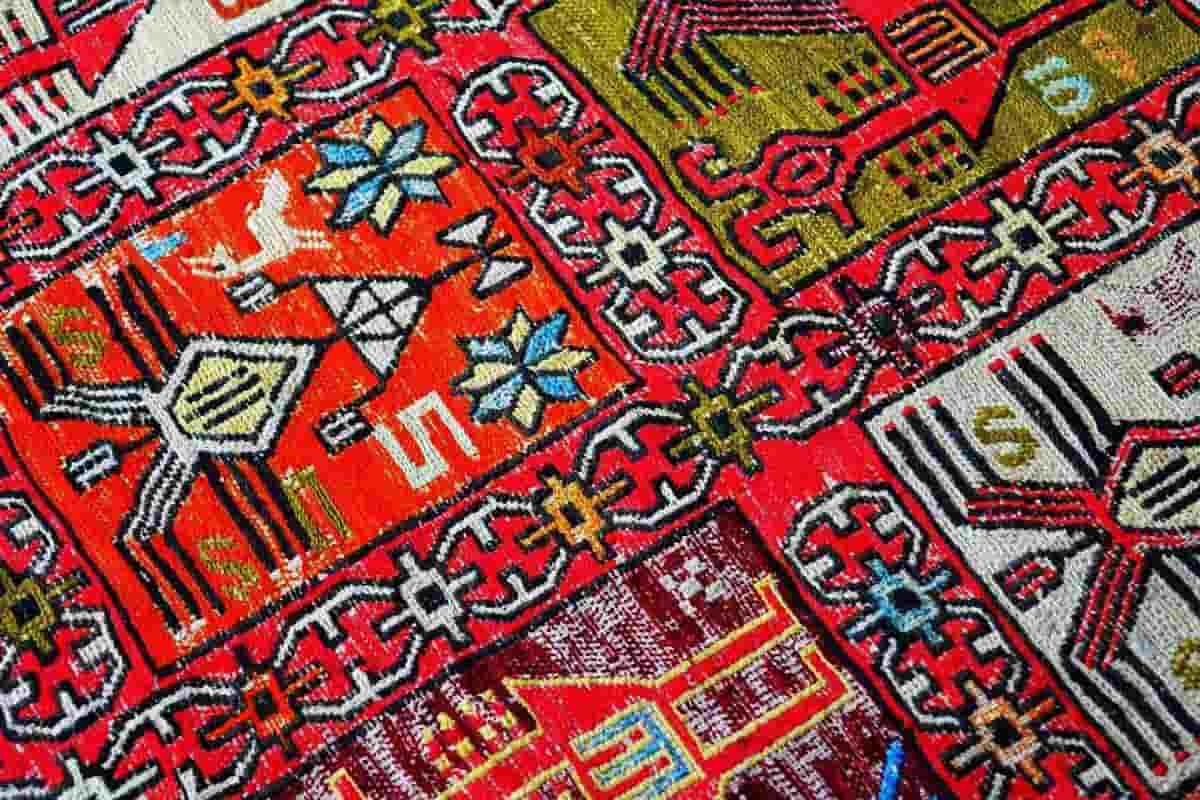If we grasp the history of the rug map and the significance of its symbols, we will be able to better appreciate the original Persian carpet designs’ meanings. In the past, the designs of original and antique Iranian carpets would tell the story of the country and the city, town, or clan where the carpet was weaved. Due to the expansion of the carpet industry at the turn of the 20th century and the proliferation of hand-woven carpet designs, it is no longer possible to pinpoint the location of carpet weaving using a map. However, it is feasible to read earlier carpets, and these unique works of art provide a glimpse into the interesting history of carpets. The carpet map consists of three major components that can be interpreted in either a curved or linear fashion: unit, repetition, and organizing method. In some patterns, the entire carpet is dominated by a single motif or theme (global design), while in others, the remainder of the design is constructed around a core motif or fringe. Iranian handmade carpet design To decipher the significance of handwoven carpet patterns, it is important to decipher the carpet's design and discover the words concealed in its weave. The names of handmade Iranian carpet maps are taken from the city, village, or clan of the weaver or seller. Carpet value criteria Handwoven carpets are more valuable than carpets produced by machines. It is possible to determine if a carpet is hand-woven or machine-woven based on its reverse. The same pattern is repeated on the back of the handcrafted carpet. Using the following criteria, the worth of the handmade carpet is determined: Knot Count: The more knots per square inch a rug has, the more valuable it is. The value of a carpet increases in proportion to the complexity of its design. Materials: Silk is the most expensive material for carpet weaving, and the nature of this natural and valuable material requires the carpet weaver to increase the number of knots per square inch to 1,000 or more. It is evident that the silk carpet is the most expensive hand-woven carpet on the market, as it is made from this rare and natural material, and as its texture becomes worn (the texture of a silk carpet sometimes takes a year). Hand-woven carpets are predominantly woven from wool. The wool produced in Iran is the highest quality and most lustrous wool in the world.
Iranian handmade carpet design To decipher the significance of handwoven carpet patterns, it is important to decipher the carpet's design and discover the words concealed in its weave. The names of handmade Iranian carpet maps are taken from the city, village, or clan of the weaver or seller. Carpet value criteria Handwoven carpets are more valuable than carpets produced by machines. It is possible to determine if a carpet is hand-woven or machine-woven based on its reverse. The same pattern is repeated on the back of the handcrafted carpet. Using the following criteria, the worth of the handmade carpet is determined: Knot Count: The more knots per square inch a rug has, the more valuable it is. The value of a carpet increases in proportion to the complexity of its design. Materials: Silk is the most expensive material for carpet weaving, and the nature of this natural and valuable material requires the carpet weaver to increase the number of knots per square inch to 1,000 or more. It is evident that the silk carpet is the most expensive hand-woven carpet on the market, as it is made from this rare and natural material, and as its texture becomes worn (the texture of a silk carpet sometimes takes a year). Hand-woven carpets are predominantly woven from wool. The wool produced in Iran is the highest quality and most lustrous wool in the world.  Antique and old carpets are typically more expensive than new carpets, although the reason for this price disparity is market demand, and old carpets are not necessarily of superior quality than new carpets. Be sure to choose a hand-woven carpet if you intend to purchase an expensive Iranian carpet. You cannot invest in machine-made carpets due to their lack of originality, durability, and aesthetic appeal. In other words, the machine-made carpet is not a real and opulent Iranian carpet, and it is merely utilized as a floor covering. A hand-woven carpet is created over the course of eight months to several years, whereas a machine-made carpet is manufactured in a matter of minutes. Designs utilized in hand-woven Iranian carpets The Herati map is one of the earliest and most common designs of genuine Iranian carpets, consisting of a rhombus-shaped design with flower motifs etched in its corners and encircled by pointed leaves. Sometimes, the Herati map is referred to as the Mahi map. The genesis of the map of Herati can be traced back to the map of the masterpiece carpet made in Kerman at the end of the 17th century and formerly owned by Baroness Alice de Rothschild. Later, the Herati pattern was utilized in all Iranian carpet-weaving centers and among the Qashqai tribes of southeastern Iran. The fish design in these carpets was woven on a much smaller and denser scale, as well as an all-over pattern on an ivory backdrop that stretched to the corners. The crab map is one of the most common national motifs. It was first woven in Khorasan and was derived from the winding palm leaf patterns of Isfahan.
Antique and old carpets are typically more expensive than new carpets, although the reason for this price disparity is market demand, and old carpets are not necessarily of superior quality than new carpets. Be sure to choose a hand-woven carpet if you intend to purchase an expensive Iranian carpet. You cannot invest in machine-made carpets due to their lack of originality, durability, and aesthetic appeal. In other words, the machine-made carpet is not a real and opulent Iranian carpet, and it is merely utilized as a floor covering. A hand-woven carpet is created over the course of eight months to several years, whereas a machine-made carpet is manufactured in a matter of minutes. Designs utilized in hand-woven Iranian carpets The Herati map is one of the earliest and most common designs of genuine Iranian carpets, consisting of a rhombus-shaped design with flower motifs etched in its corners and encircled by pointed leaves. Sometimes, the Herati map is referred to as the Mahi map. The genesis of the map of Herati can be traced back to the map of the masterpiece carpet made in Kerman at the end of the 17th century and formerly owned by Baroness Alice de Rothschild. Later, the Herati pattern was utilized in all Iranian carpet-weaving centers and among the Qashqai tribes of southeastern Iran. The fish design in these carpets was woven on a much smaller and denser scale, as well as an all-over pattern on an ivory backdrop that stretched to the corners. The crab map is one of the most common national motifs. It was first woven in Khorasan and was derived from the winding palm leaf patterns of Isfahan. motifs and designs found on Iranian hand-woven carpets The techniques for designing the maps on hand-woven Iranian carpets date back thousands of years and have been passed down as a priceless inheritance from generation to generation. There is little written evidence on handwoven rug designs, and no two handwoven carpets are identical. Weavers from different cities, villages, and tribes in Iran employ their own materials and designs to make their own distinctive carpets. Wool has been the most commonly used material for weaving durable and best-selling carpets up until now. Finally, sheep wool is used to weave carpets and other things after being dyed and spun. The carpet weaved by nomadic artists is carried down from the roof and shipped to markets in various locations throughout the world for sale. Each tribe has its own ideals and beliefs, and the nomadic carpet is an artistic representation of the weaver's real convictions that the Lord is ever-present and watchful. Many Iranians depend on this unique craft for their livelihood. Symbols and themes on handmade Iranian carpets Asterism and good fortune Lotus: immortality and rebirth Mihrab is a portal to heaven. Lily: chastity and religion Herati: fish, aquatic garden The Tree of Life is a direct route to heaven
motifs and designs found on Iranian hand-woven carpets The techniques for designing the maps on hand-woven Iranian carpets date back thousands of years and have been passed down as a priceless inheritance from generation to generation. There is little written evidence on handwoven rug designs, and no two handwoven carpets are identical. Weavers from different cities, villages, and tribes in Iran employ their own materials and designs to make their own distinctive carpets. Wool has been the most commonly used material for weaving durable and best-selling carpets up until now. Finally, sheep wool is used to weave carpets and other things after being dyed and spun. The carpet weaved by nomadic artists is carried down from the roof and shipped to markets in various locations throughout the world for sale. Each tribe has its own ideals and beliefs, and the nomadic carpet is an artistic representation of the weaver's real convictions that the Lord is ever-present and watchful. Many Iranians depend on this unique craft for their livelihood. Symbols and themes on handmade Iranian carpets Asterism and good fortune Lotus: immortality and rebirth Mihrab is a portal to heaven. Lily: chastity and religion Herati: fish, aquatic garden The Tree of Life is a direct route to heaven  Women are represented by the rhombus shape. Two interlocking rhombuses signify a man and a woman, respectively. The Bird of Paradise: Paradise Shoulder: Sacredness The Peacock: Eternity Dog: perfection, trust, defense Teapot, jar: purification Parrot: flight from danger, protection Amulet: protection against irritated eyes Duck, swan: female fertility, magic Revival, Hyacinth Eagle: Might Fertility via Pomegranate Bird: faith and procreation Leaf: unending regeneration Protection and enlightenment Cedar: renewal and tranquility Dragon: Power Tulip: Blooming Innocence is symbolized by the white rose. Red Rose: Emotion Common Mystery: Rose The man as a symbol of the carpet weaving Bloom: youth, spring, and a newlywed couple Camel: money and success
Women are represented by the rhombus shape. Two interlocking rhombuses signify a man and a woman, respectively. The Bird of Paradise: Paradise Shoulder: Sacredness The Peacock: Eternity Dog: perfection, trust, defense Teapot, jar: purification Parrot: flight from danger, protection Amulet: protection against irritated eyes Duck, swan: female fertility, magic Revival, Hyacinth Eagle: Might Fertility via Pomegranate Bird: faith and procreation Leaf: unending regeneration Protection and enlightenment Cedar: renewal and tranquility Dragon: Power Tulip: Blooming Innocence is symbolized by the white rose. Red Rose: Emotion Common Mystery: Rose The man as a symbol of the carpet weaving Bloom: youth, spring, and a newlywed couple Camel: money and success
💰 Tenfold your income 💎
